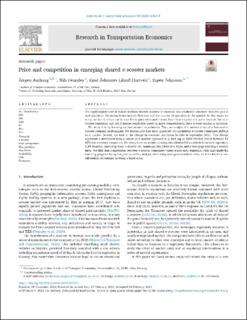| dc.contributor.author | Aarhaug, Jørgen | |
| dc.contributor.author | Fearnley, Nils | |
| dc.contributor.author | Hartveit, Knut Johannes Liland | |
| dc.contributor.author | Johnsson, Espen | |
| dc.coverage.spatial | Norway, Oslo | en_US |
| dc.date.accessioned | 2023-06-29T12:26:37Z | |
| dc.date.available | 2023-06-29T12:26:37Z | |
| dc.date.created | 2023-03-07T15:34:58Z | |
| dc.date.issued | 2023-03-07 | |
| dc.identifier.citation | Research in Transportation Economics. 2023, 98 (May 2023), 1-8. | en_US |
| dc.identifier.issn | 0739-8859 | |
| dc.identifier.uri | https://hdl.handle.net/11250/3074366 | |
| dc.description | Jørgen Aarhaug, Nils Fearnley, Knut Johannes Liland Hartveit, Espen Johnsson, Price and competition in emerging shared e-scooter markets, Research in Transportation Economics, Volume 98, 2023, 101273, ISSN 0739-8859, https://doi.org/10.1016/j.retrec.2023.101273. | en_US |
| dc.description.abstract | The rapid deployment of shared dockless electric scooters (e-scooters) has resulted in attention from the public and regulators. Recurring issues include fleet size and the number of operators in the market. In this paper we study market development in two Norwegian cities and discuss how these experiences point towards future e-scooter regulation and ask if market regulation based on price competition in the e-scooter market is plausible. We study this by focusing on two natural experiments. First, we analyse the market entry of a low-cost e-scooter company in Drammen. We discuss how that entry impacted two incumbent e-scooter companies and the total market. Second, we look at the change in e-scooter regulation in Oslo in September 2021. This change represents a movement from a laissez faire market approach to a fleet cap of 8000 divided evenly between 12 different e-scooter companies. We study these experiments using data obtained from selected e-scooter operators (GPS location, start/stop time, e-scooter id), municipalities (fleet size, trips) and a web page tracking e-scooter fares. We find that competition between e-scooter companies varies across user segments, with trips made for traveling purposes being less price sensitive, and joy rides being more price sensitive. Also, we find that there are substantial advantages in being a large actor. | en_US |
| dc.language.iso | eng | en_US |
| dc.publisher | Elsevier | en_US |
| dc.rights | Navngivelse 4.0 Internasjonal | * |
| dc.rights.uri | http://creativecommons.org/licenses/by/4.0/deed.no | * |
| dc.subject | e-scooter | en_US |
| dc.subject | Price competition | en_US |
| dc.subject | Micromobility | en_US |
| dc.subject | Regulation | en_US |
| dc.subject | Availability | en_US |
| dc.subject | Oslo | en_US |
| dc.subject | Norway | en_US |
| dc.title | Price and competition in emerging shared e-scooter markets | en_US |
| dc.title.alternative | Price and competition in emerging shared e-scooter markets | en_US |
| dc.type | Journal article | en_US |
| dc.type | Peer reviewed | en_US |
| dc.rights.holder | © 2023 The Authors. Published by Elsevier Ltd. | en_US |
| dc.source.articlenumber | 101273 | en_US |
| dc.description.version | publishedVersion | en_US |
| cristin.ispublished | true | |
| cristin.fulltext | original | |
| cristin.qualitycode | 1 | |
| dc.identifier.doi | 10.1016/j.retrec.2023.101273 | |
| dc.identifier.cristin | 2132042 | |
| dc.source.journal | Research in Transportation Economics | en_US |
| dc.source.volume | 98 | en_US |
| dc.source.issue | May 2023 | en_US |
| dc.source.pagenumber | 1-8 | en_US |
| dc.relation.project | Norges forskningsråd: 321050 | en_US |
| dc.relation.project | Norges forskningsråd: 316579 | en_US |
| dc.relation.project | Norges forskningsråd: 283331 | en_US |

